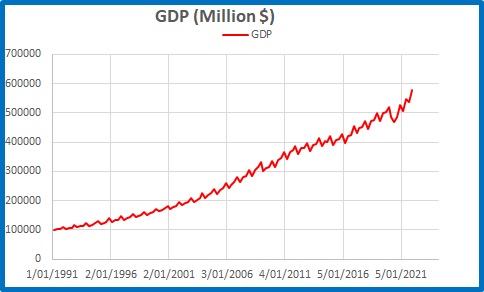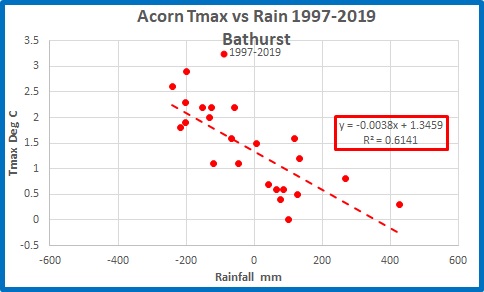In my last post I showed that maximum temperature (Tmax) as reported by ACORN-SAT (Australian Climate Observations Reference Network-Surface Air Temperature) appears to be responsible for the growing divergence of the difference between Tmax and tropospheric temperatures from Australia’s rainfall.
In this post I show how Tmax is related to rainfall, and show that while this relationship holds for discrete periods throughout the last 110 years, Tmax has apparently diverged from what we would expect. In other words, the Acorn Tmax record is faulty and unreliable.
For much of this analysis I am indebted to Dr Bill Johnston who has posted a number of papers at Bomwatch using the relationship between Tmax and rainfall.
At any land based location annual maximum temperature varies with rainfall: wet years are cooler, dry years are warmer. More rainfall (with accompanying clouds that reflect solar radiation) brings cooler air to the ground; provides more moisture in the air, streams, waterholes, and the soil which cools by evaporation; causes vegetation to grow, the extra vegetation shading the ground and retaining moisture, with transpiration providing further cooling; and in moist conditions deep convective overturning moves vast amounts of water and heat high into the troposphere- especially evident in thunderstorms. Less rainfall means the opposite: more solar radiation reaches the ground with fewer clouds and less vegetation; there is less moisture available to evaporate; less vegetation growth and transpiration; and much less heat is transferred to the troposphere through convective overturning.
While more rainfall than the landscape can hold results in runoff in rivers and streams, thus removing some moisture from the immediate area, this affects large regions only in tropical coastal catchments- the Kimberleys, the Gulf rivers, the Burdekin and Fitzroy. Across the bulk of Australia there is very little discharge of water to the oceans. In the Murray-Darling Basin, on average less than 0.005% of rainfall is discharged from the Murray mouth. (BOM rainfall data and 1891-1985 discharge data from Simpson et al (1993))
This temperature ~ rainfall relationship is particularly evident in desert areas far from any marine influence. Alice Springs provides a good example. Figure 1 shows how annual maximum temperatures at Alice Springs Airport vary with rainfall since 1997. Data are from ACORN.
Fig. 1: Tmax and Rainfall, Alice Springs
The slope of the trend line shows that for every extra millimetre of rain, Tmax falls by 0.0047 of a degree Celsius, which is about half a degree less for every 100 mm. The R-squared value shows that there is a good fit for the data- 79% of temperature change is due to rainfall.
I said above that this relationship holds for land locations. An island, with a little land surrounded by water, is mostly affected by sea temperature and wind direction. Locations near the coast are also affected by marine influence. At Amberley in south-east Queensland daily maximum temperature can be moderated by the time of arrival of a sea breeze or whether it arrives at all. (Site changes also can change Tmax recorded.)
Fig. 2: Tmax and Rainfall, Amberley
Further inland, the relationship is strong: at Bathurst, there is 0.4C temperature variation per 100mm of rainfall and 61% of temperature change is due to rainfall alone.
Fig. 3: Tmax and Rainfall, Bathurst
The BOM has sophisticated algorithms for area averaging temperature and rainfall across Australia and provide national climate records back to 1900 for rainfall and 1910 for maxima. Averaged across Australia individual station idiosyncrasies are submerged so that the 1997 to 2019 relationship between Tmax and rainfall is very strong (and similar to that of Alice Springs):
Fig. 4: Tmax and Rainfall, Australia 1997-2019
However, the relationship is not strong throughout the whole record:
Fig. 5: Tmax and Rainfall, Australia 1910-2019
The relationship from 1910 to 2019 is poor.
In the next figure I compare the Tmax – rainfall relationships for the first 10 years of the record with the last 10 years.
Fig. 6: Tmax and Rainfall, Australia, first and last decades
The trendlines are almost exactly parallel, with tight fits, showing strong relationships 100 years apart- but the trendline for 2010 to 2019 is about 1.7 degrees above that for 1910 – 1919. How can that be?
It is possible to compare rainfall and temperature throughout the last 110 years. In the next figure, rainfall is inverted and scaled down so as to match Tmax at 1910.
Fig. 7: Tmax and Inverted Scaled Rain, Australia
Running 10 year means allow us to see long term patterns of rainfall and temperature more easily:
Fig. 8: Tmax and Inverted Scaled Rain, Decadal Means, Australia
Rainfall has increased over the last 110 years (despite what you might hear in the media), and so apparently have maximum temperatures. In the above figures Tmax and rainfall track roughly together until the mid-1950s, then Tmax takes off.
I calculated an “index” of temperature ~ rainfall variation by subtracting scaled, inverted rainfall from Tmax, commencing at zero in 1919. This allows us to identify when temperature appears to diverge markedly from inverted rainfall:
Fig. 9: Index of Temperature ~ Rainfall Variation: Tmax minus Inverted Scaled Rain, Decadal Means, Australia
There is a small increase from the mid-1950s, but the really large divergence commences in the 1970s, with the decade from 1973 to 1982 about 0.6 units above the decade to 1972. The index decreases to 1995, then there is another steep increase to 2007, and a final surge to 2019.
This index alone shows how poorly the official temperature record represents the temperature of the past.
While there are other times, in the next figures I compare four periods: 1910 to 1972, 1973 to 1995, 1996 to 2007, and 2008 to 2019. Here I use annual data.
Fig. 10: Tmax and Rainfall, Australia, four periods
Again, trendlines are almost parallel with similar slopes, showing that the Tmax ~ rainfall relationship is fairly constant for all periods- (about 0.5C per 100mm after 1995 and about 0.4C per 100mm before 1995). However, the lines are separated. Temperature for each later period is higher than the ones preceding, such that the temperature recorded now is about 1.5 degrees Celsius higher than it would have been for similar rainfall before 1973. And rainfall has increased in that time.
Global Warming Enthusiasts and apologists for the BOM will claim that these breaks between separate periods are real and caused by changes in circulation patterns due to climate change- in particular the Southern Annular Mode. That will be the subject of Part 2.
Whatever the reasons, Australia wide the Tmax ~ rainfall relationship has remained constant for the past 110 years (as it should) but the temperatures reported in the Acorn dataset have increased by more than 1.5 degrees Celsius relative to rainfall.
Conclusion:
The ACORN-SAT temperature dataset is an unreliable record of Australia’s maximum temperatures.














































